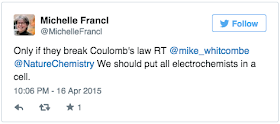 |
| Woman teaching geometry to men illus. 14th century copy of Euclid's Elements |
"Not only did Scottish mathematician, science writer, and polymath Mary Fairfax Somerville (December 26, 1780–November 28, 1872) defy the era’s deep-seated bias against women in science, she was the very reason the word “scientist” was coined: When reviewing her seminal second book, On the Connexion of the Physical Sciences, which Somerville wrote at the age of 54, English polymath and Trinity College master William Whewell was so impressed that he thought it rendered the term “men of science” obsolete and warranted a new, more inclusive descriptor to honor Somerville’s contribution to the field." — from Maria Popova and Lisa Congdon's 2013 project The ResurrectionistsOddly enough, I'd read William Whewell's review of Somerville's On the Connexion of the Physical Sciences while writing an essay about the public conception of scientists, and my recollection was that the coining of scientist, while reported in this review, was not in fact spurred by Somerville's work. So I went back and read it again.
Whewell was certainly impressed with Somerville and her book, but his tale of the creation of the word 'scientist' makes no mention of honoring Somerville or her contribution. About the only person Whewell seems impressed with in this context is the "ingenious gentlemen," thought to be himself!
A curious illustration of this result maybe observed in the want of any name by which we can designate the students of the knowledge of the material world collectively. We are informed that this difficulty was felt very oppressively by the members of the British Association for the Advancement of Science, at their meetings at York, Oxford, and Cambridge, in the last three summers. There was no general term by which these gentlemen could describe themselves with reference to their pursuits. Philosophers was felt to be too wide and too lofty a term, and was very properly forbidden them by Mr. Coleridge, both in his capacity of philologer and metaphysician ; savans was rather assuming, besides being French instead of English; some ingenious gentleman proposed that, by analogy with artist, they might form scientist, and added that there could be no scruple in making free with this termination when we have such words as sciolist, economist, and atheist—but this was not generally palatable; others attempted to translate the term by which the members of similar associations in Germany have described themselves, but it was not found easy to discover an English equivalent for natur-forscher. The process of examination which it implies might suggest such undignified compounds as nature-poker, ornature-peeper, for these naturae curiosi; but these were indignantly rejected." [from the Quarterly Review, 1834, emphasis mine]Interestingly, Wherwell does tackle the issue of women in philosophy/science: "Our readers cannot have accompanied us so far without repeatedly feeling some admiration rising in their minds, that the work of which we have thus to speak is that of a woman." It's a fascinating read, in which you can see the threads of imagery that is still current (and still unsupported by data) about the innate differences between the minds of men and women.
And in the end, scientist would catch on, by the early 20th century it was far eclipsed "natural philosopher" as the preferred general term.
























